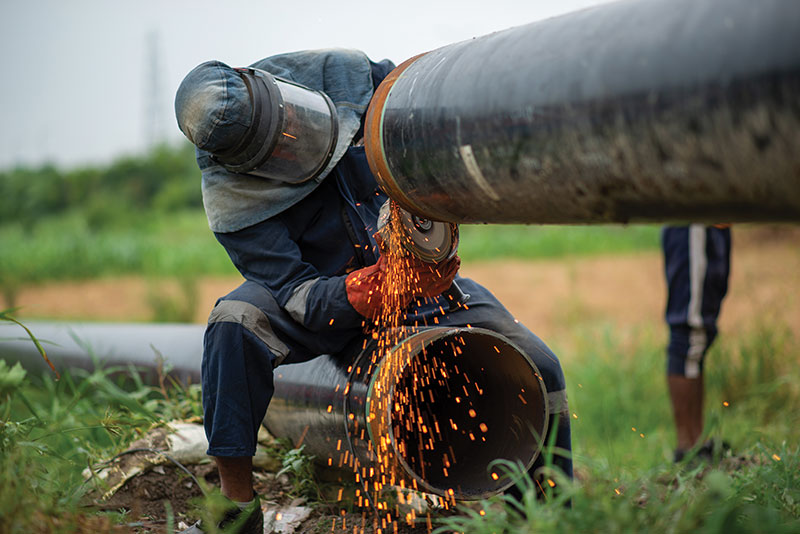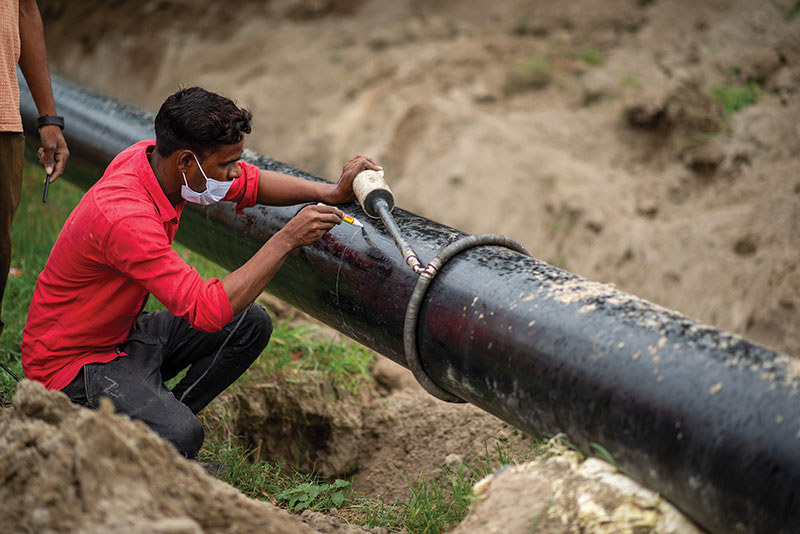June 2022, Vol. 249, No. 6
Features
India Moves to Modernize, Expand Gas Pipeline Network
By Gordon Feller, P&GJ Contributor
Indian government says that it foresees an increase in the share of natural gas in the country’s energy mix – from 6% in 2021 to 15% by 2025. A total of $60 billion of new investment planned in the country’s natural gas infrastructure by 2024, with most of that coming from the private sector.
There is an expectation that $15.8 billion in new investment will be made over the coming 10 years.
India currently has miles 10,563 miles (17,000 km) of pipelines, and it plans now to increase this to 1,8641 miles (30,000 km) by 2025. India has six existing LNG terminals, with a total regasification capacity of 39.2 mtpa. The current total estimate for reserves of natural gas in India is 1.34 trillion cubic meters.
Nationally, natural gas demand is slated to grow from 63 Bcm in 2019 to 131 Bcm in 2030. This is according to the government’s “Stated Policy Scenario” as published in the “India Energy Outlook 2021.”
India is the third-largest energy and oil consumer in the world – after China and the US. India is the fourth-largest importer of liquefied natural gas. India consumed 213.13 MMT petroleum products and 64.14 Bcm natural gas in FY 2019-20, marking a growth of 0.4% and 5.5% over the FY 2018-19 consumption levels. India’s oil demand rises by almost 4 MMbpd to reach 8.7 MMbpd in 2040.
This is the largest increase of any country. India is working to become a gas-based economy by increasing the share of natural gas in India’s energy mix from 6.3% to 15% by 2030.
The operator of Europe’s largest natural gas transmission network is planning to invest in India’s gas pipeline business. Moving quickly on the deal, the Italian-based company Snam has recruited as its adviser B.C. Tripathi, the former chairman of conglomerate the Gas Authority of India Ltd. (GAIL).
Discussions have been taking place on a regular basis for the past few months. Snam’s top executives, Dharmendra Pradhan, the national minister for Petroleum & Natural Gas and Steel, other Indian government officials, Indian regulators, and some of India’s top industrial executives – all are now involved in these on-going deliberations.
The participants are trying to understand the full scope of each of the specific investment opportunities. They are also trying to assess the sometimes quite unpredictable regulatory landscape, a climate which has prevailed for some time in India. Negotiations now include several specific categories: hydrogen fuel, gas storage, and small-scale liquefaction technologies.
Snam’s major focus is primarily being placed on pursuing investment opportunities in the gas pipeline business.
“We look forward to opening soon our office in India to enhance the dialogue and cooperation with Indian partners that we have developed over the past couple of years,” said Snam CEO Marco Alverà. “For the time being we decline to comment further on specific projects until there are concrete developments.”
In July 2020, Snam formed a consortium with five international investment funds to acquire a 49% stake in ADNOC Gas Pipelines, in the UAE, for $10.1 billion.
Last year saw a new idea put forward by NITI Aayog, a policy think-tank of the Government of India. Nit Aayog proposed keeping off GAIL’s pipeline assets and monetizing it. But NITI Aayog has encountered resistance from the company’s Board, as well as from the petroleum ministry.
GAIL owns about 6,835 miles (11,000 km) of gas pipelines across the country and is currently planning to shift all its pipeline assets to a wholly owned subsidiary. Chaired by PM Narendra Modi, NITI Aayog was established with the aim to achieve sustainable development goals with cooperative federalism by fostering the involvement of State Governments of India in the economic policy-making process using a bottom-up approach.
Snam currently operates businesses in Italy, the U.K., France, Austria, Greece, and China. The company plans to use its deep gas sector knowledge to propel itself into India’s marketplace.
“Regarding India, the significant push towards cleaner energy shift and towards gas is what makes the country interesting for Snam. This will require infrastructures and an integrated management of those infrastructures, which is where Snam has 80 years of history and proven track record,” Alverà said.
He often reminds the press and media that Snam can offer technology and equipment for compressed natural gas refueling stations. “Snam is also working on an innovative modular approach to liquefaction that would enable liquefaction of gas at very competitive costs to foster city gas distribution and to monetize local stranded gas reserves,” Alverà said.
Why now is India seeing these big moves by Snam? Some of India’s small gas fields are not yet connected to any pipelines. An “inexpensive” liquefaction facility can help evacuate such gas. India’s government is pushing hard to expand the use of natural gas in transport. The national ministries are helping to set up new LNG regasification terminals. Additionally, the central government has given away more than 100 city gas distribution licenses in the past three years to increase population’s access to CNG.
The government-owned Indian Oil Corporation Ltd. (IndianOil) operates a 13,391-km network of crude, gas and product pipelines, with a capacity of 1.896 MMbpd of oil and 9.5 MMscm/d of gas.
This is 30% of the nation’s total pipeline network. IndianOil is the largest commercial oil company in the country, with total revenues of $88 billion in 2019. IndianOil is 56.98% state-owned.
The nation’s top three companies – IndianOil, Hindustan Petroleum Corporation Ltd., Bharat Petroleum Corporation Ltd. – contribute more than 80% of the total length of the gas pipeline network in the country. (HPCL is 51.11% state-owned, through a holding of 42.75% by ONGC. BPCL is 54.31% state-owned.)
As of May 2022, GAIL has the largest share (71.61%) and 7090 miles (11,411 km) of the country’s natural gas pipeline network. The total for the whole country is 16,324 km.
In January 2020, the central government announced plans to invest $9.97 billion to expand the gas pipeline network across the country. One reason for this big move within a budget-constrained environment is this: even with the pandemic’s dampening effect on the national economy, experts inside the government and the private sector believe that India’s consumption of natural gas will almost certainly increase more than threefold in next 10 years.
LNG regasification has become a national priority. H-Energy (aka Hiranandani Energy) is a Mumbai-based private firm which plans to invest $540.62 million in order to build LNG terminals and lay down a 37-mile (60-km) pipeline.
H-Energy is one of the leading natural gas companies in India, providing LNG solutions since it was established in 2009. In 2018 H-Energy inaugurated India’s Floating Storage Re-gasification Unit (FSRU) based LNG Terminal. This facility is located at the JSW Jaigarh Port.
The national Ministry is targeting a total of $100 billion worth investment in gas infrastructure by 2022. The Minister said that he wants to see the government add another 228 cities to India’s existing gas distribution (CGD) network. This would include setting up RLNG terminals, pipeline projects, completing the gas grid and setting up of the CGD network in more cities.
The government’s estimates that oil and gas industry could attract US$ 25 billion investment in exploration and production by 2022. India’s energy demand is expected to double to 1,516 mtpa by 2035, from a total in 2017 of 753.7 Mtoe. India’s share in global primary energy consumption is projected to increase two-fold by 2035.
LNG imports accounted for about one-fourth of total gas demand, and the total demand is estimated to double over the next five years. To meet this rising demand for gas the national government wants to increase its LNG import capacity to 50 MT. Indian government executives, together with private industry executives, are increasingly aware of how reliant the country has become on imported LNG.
To encourage greater capital flows into gas and oil, the national government has allowed 100% foreign direct investment (FDI) in upstream and private sector refining projects. The FDI limit for public sector refining projects has been raised to 49% without any disinvestment or dilution of domestic equity in existing state-owned entities.
In September 2018, the national government approved fiscal incentives to attract the specifics investments and technologies which would improve the productivity of India’s oil and gas fields. When enacting these measures, the Ministry said that it expected hydrocarbon production worth $745.8 billion in the next 20 years.
FDI inflow in India’s petroleum and natural gas sector stood at $7.8 billion during the months of April 2000 to March 2020. The government plans to invest, from its own budget, $2.8 billion in upstream oil and gas production to double the natural gas production to 60 Bcm and drill more than 120 exploration wells by 2022.
The government’s new Open Acreage Licensing Policy allows an explorer to study the data available and bid for blocks of his choice. The focus has been on increasing foreign participation by global E&P companies like Shell, BP, Conoco Phillips etc.
The government put 14 blocks up for auction in the second-round of OALP, with expected investments worth $ 5.6 billion.







Comments